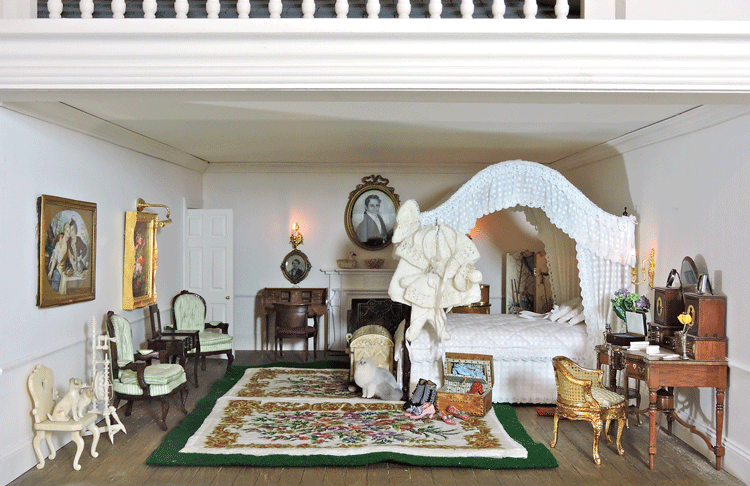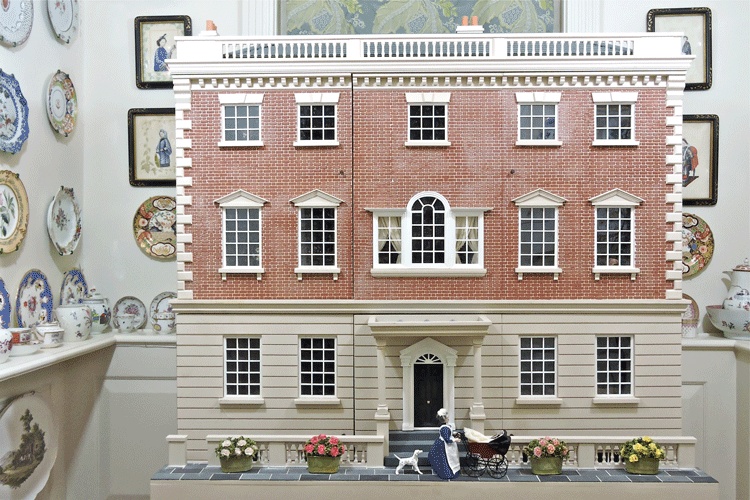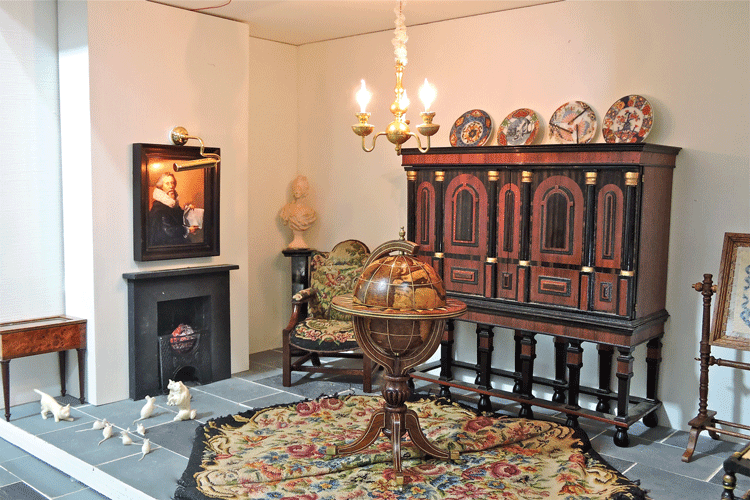A MOST PERFECT WORLD

By Dulcy B. Hooper
Photos by Richard Hooper
“I didn’t have a dollhouse as a child,” said Margaret Gardner, “so I suppose I am having a second childhood through these.”
Gardner has more than made up for lost time. Her first dollhouse, acquired nearly 30 years ago, came from a make-it-yourself kit. “I put it all together myself,” she recalled, “even the furniture.” A few years later, she purchased a Victorian era dollhouse from Margaret Lee, formerly head of Foxcroft’s riding department.
“It had been in her husband’s family for years,” Gardner said. “I used to go to the Washington Doll’s House and Toy Museum to find furniture and other accessories for the Lee house.” (Founded in 1975 by Flora Gill Jacobs, an internationally recognized authority on dollhouses, the Museum attracted more than 20,000 visitors annually during its nearly three decades in NW Washington.)
Following a lull of many years, during which time Gardner immersed herself in other interests, dollhouses were “on the back burner, but still simmering,” she said. “I would continue to pick up dollhouses here and there, but what I had always really wanted was a classic English Georgian dollhouse.”

It took a year to get the house she wanted, one created by Tim Hartnall of Anglia Dolls Houses in Norfolk in the United Kingdom. According to Hartnall, many collectors are drawn to Georgian buildings, which he describes as “the sort of home in which you would like to live.” During the construction of Gardner’s house, Hartnall sent his anxious client frequent updates to keep her abreast of his progress.
“This week’s crop of pictures is attached,” he wrote in one update. “As you will see . . . we have made good progress and worked today to make up some of the lost time. The stairs are all made, the kitchen arch with bread oven is done and nearly all the skirting, architrave, doors and the strip wood for making the paneling is top-coated . . . The kitchen details, fireplaces, hearths and all the lights and electrical components have arrived from the various suppliers.”
In another update, Hartnall reported that, “I have had to make one substitution of components relative to the pictures that you have seen (in your favor, I hasten to add). The fancy built-up ceiling moulding in the ground floor reception rooms and the first floor landing included a wooden Greek key moulding used as a frieze on the vertical face. This is no longer available . . . so I have instead substituted real plaster friezes . . .”

When it finally arrived, Gardner was thrilled. “I just couldn’t have been happier,” she said. “And then I proceeded to decorate it.” Decorate she did—creating a perfect world in each of the 12 rooms visible from the front of the dollhouse.
The elaborate interiors include an array of stunning miniatures by some of the most well-known craftsmen (and women) in the field, a number of which are one of a kind. Gardner connected with the works of many of these artists through Greg Madl of Swan House Miniatures. Madl specialize in miniatures and represents more than 300 artists in the field.
“What these artists create,” said Madl, “are truly spectacular pieces of artwork. I have always admired artists, and these are absolutely artists in every sense. In fact, a great number of the pieces that Margaret [Gardner] has collected can stand alone as decorative items of art.”
Madl represents American, French and English artists, among others. Gardner is particularly pleased with the paintings by Johannes Landman, which are lit up as they would be in a proper Georgian home, with miniature picture lights.

Among the furniture and accessories that decorate the rooms are crystal chandeliers by Jason Getzan, an Herbillon harpsichord and bureau, rare wood tables by John Hodgson, a globe by Michael Walton (one of only three in existence), crystal by Jim Irish, tapestry doghouses, a gold compote with fruit by Stephan O’Meara, commodes and chests by David Iriarte, and period chairs by Michael Walton. Some of the carpets are hand-knotted like real carpets, only in miniature. Others are created out of Viennese petti point evening bags that were in vogue during that time. The dining room table is set with paper-thin, hand-painted porcelain, and there is a porcelain tea set.
“What she [Gardner] has done is very impressive,” said Madl. “A lot of people don’t realize that there is this level of detail and artistry in dollhouses. She has taken it to another level altogether, one in which beautiful pieces of art are put together to create a theme and a story in a dollhouse.”
Along with the furniture and accessories, Gardner is very particular about the inhabitants of the house. “They must be contemporary with the period,” she said.
Among those inhabitants: A set of seven ivory mice. “When I was in Barcelona, I saw the mice, and I said, ‘I’ve got to have these.’ I’m pretty much done now, but I had to have the mice.” ML


